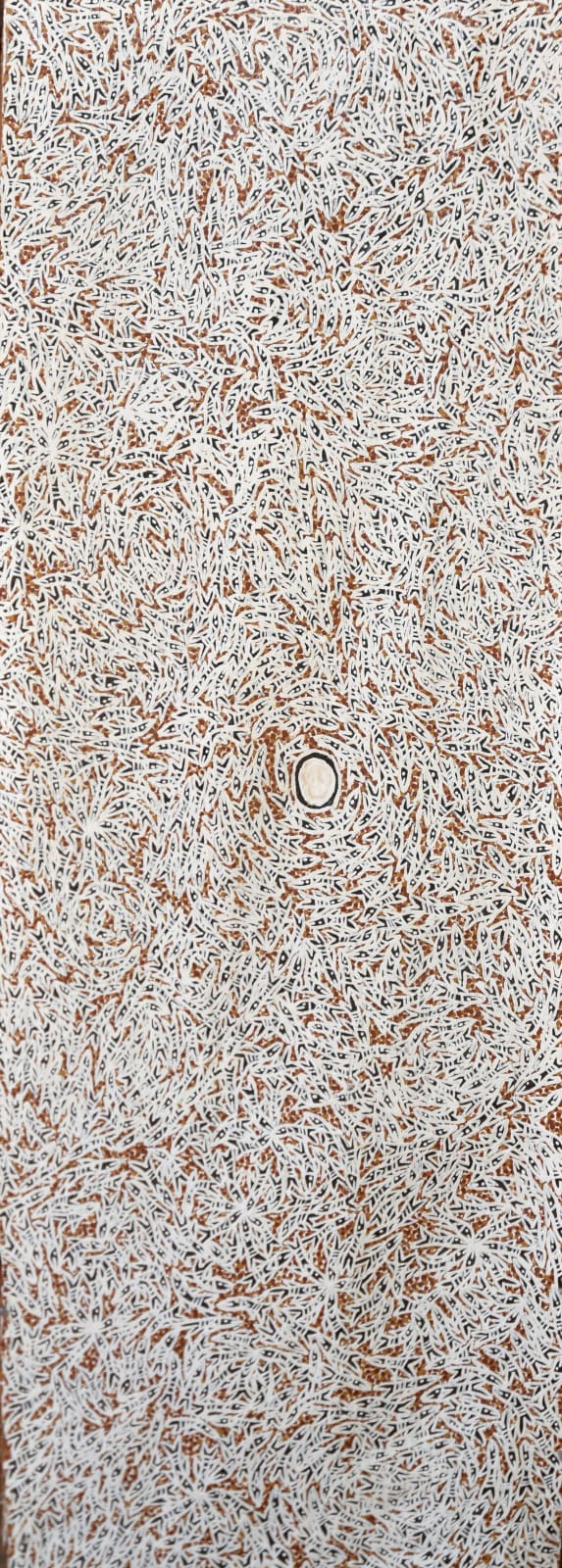NORTHERN WATERS: ARTWORKS FROM MANINGRIDA, YIRRKALA & INJALAK
Past exhibition
Wukun Wanambi Australian, Gurka’wuy, b. 1962
Bamarrungu
120 x 40 cm
3726M
Trial Bay is located between Caledon bay to the north and above the larger Blue Mud Bay on the western side of the Gulf of Carpentaria. Deep inside Trial Bay...
Trial Bay is located between Caledon bay to the north and above the larger Blue Mud Bay on the western side of the Gulf of
Carpentaria. Deep inside Trial Bay the Marrakulu clan claim ownership to land and sea though the actions and events of
Ancestor Beings as they travelled into this country imbuing both land and sea. The mark of ownership is sung, danced and
painted in Marrakulu ritual through the stringybark woodlands and stony country, through the freshwaters running into the
Gurka’wuy River into trial Bay. Mixing with the saltwaters through sacred mangroves and froth and bubble and out deeper into
the Bay with the outgoing Ɵde, past boulders and rocky islets the power and knowledge associated with Marrakulu Rom (law)
washes back to shore. This country is associated with the Wawalak Sisters, sacred goannas, Wuyal the Sugerbag Man and the
original inhabitants of Gurka’wuy since these times, the Djuwany people. The Djuwany were the first people of this country
who practised the ritual according to the Creators on the beaches, who hunted the stony country and waters of both the River
and Trial Bay. This painting refers to Bamurruŋu, a sacred and solitary rock in Trial Bay. It is a white dome in the Bay - a round
lump of granite its top coloured by roosting birds, in the painƟng by the molmulpa or white sea foam associated with turbulent
and agitating waters created by particular tide and wind. The fish swim up to Bamurruŋu and referred to as Marparrarr or milk
fish, somewhat like a large mullet. According to the artist these were once people of the stone country behind where the
Marrakulu have now settled close the mouth of the Gurka’wuy river. They turned to Marparrarr on reaching the shore and
following the feathered string to Bamurruŋu. The Beings of Marparrarr were the ‘same’ as the original inhabitants of Gurka’
wuy, in this manifestation, populating Marrakulu sea country as land totems do in this area. Yolŋu of this area speak of a hole
submerged under the rock, from where bubbles are seen rising to the surface, sometimes bursting forth with a rush. The
bubbles are seen as a life force and a direct Ancestral connection for the Marrakulu. The Marparrarr have knowledge of this
special phenomenon as do the law men. The artist explained that here was a ‘statue’ for Mali Djuluwa Makaratjpi. When the
Marrakulu perform ritual dance for the events depicted in this painting participants move towards a held spear representing
the steadfastness of the rock, splittng the dancers who then surround Bamurruŋu moving as does the sea to song and rhythm
of Yidaki and Bilma.
Carpentaria. Deep inside Trial Bay the Marrakulu clan claim ownership to land and sea though the actions and events of
Ancestor Beings as they travelled into this country imbuing both land and sea. The mark of ownership is sung, danced and
painted in Marrakulu ritual through the stringybark woodlands and stony country, through the freshwaters running into the
Gurka’wuy River into trial Bay. Mixing with the saltwaters through sacred mangroves and froth and bubble and out deeper into
the Bay with the outgoing Ɵde, past boulders and rocky islets the power and knowledge associated with Marrakulu Rom (law)
washes back to shore. This country is associated with the Wawalak Sisters, sacred goannas, Wuyal the Sugerbag Man and the
original inhabitants of Gurka’wuy since these times, the Djuwany people. The Djuwany were the first people of this country
who practised the ritual according to the Creators on the beaches, who hunted the stony country and waters of both the River
and Trial Bay. This painting refers to Bamurruŋu, a sacred and solitary rock in Trial Bay. It is a white dome in the Bay - a round
lump of granite its top coloured by roosting birds, in the painƟng by the molmulpa or white sea foam associated with turbulent
and agitating waters created by particular tide and wind. The fish swim up to Bamurruŋu and referred to as Marparrarr or milk
fish, somewhat like a large mullet. According to the artist these were once people of the stone country behind where the
Marrakulu have now settled close the mouth of the Gurka’wuy river. They turned to Marparrarr on reaching the shore and
following the feathered string to Bamurruŋu. The Beings of Marparrarr were the ‘same’ as the original inhabitants of Gurka’
wuy, in this manifestation, populating Marrakulu sea country as land totems do in this area. Yolŋu of this area speak of a hole
submerged under the rock, from where bubbles are seen rising to the surface, sometimes bursting forth with a rush. The
bubbles are seen as a life force and a direct Ancestral connection for the Marrakulu. The Marparrarr have knowledge of this
special phenomenon as do the law men. The artist explained that here was a ‘statue’ for Mali Djuluwa Makaratjpi. When the
Marrakulu perform ritual dance for the events depicted in this painting participants move towards a held spear representing
the steadfastness of the rock, splittng the dancers who then surround Bamurruŋu moving as does the sea to song and rhythm
of Yidaki and Bilma.
